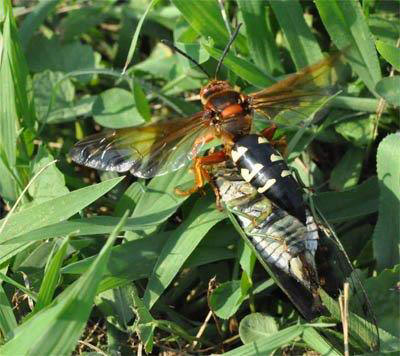Nutrition
Wasps are thought to be very beneficial for humans. One major
benefit that wasps provide is keeping the population size of
many insects at a controlled level. Another benefit that humans
see is the pollination of flowers (Drees
and Jackman, 1998).
Mature cicada killers eat
fermented sap from large plants. Sap is the insect's primary
source for water and carbohydrates (Clark,
1937). Cicada killers will pollinate flowers as they move
from one to another gathering food (Drees
and Jackman, 1998). Immature cicada killers are
carnivores feeding on cicadas. Young are brought paralyzed
cicadas by their mothers to feed on. Sphecius speciosus are known to hunt thirty species of
cicadas (Holliday and Coehlo, 2009). Because
cicada killers are usually smaller than the cicadas
that they prey upon, cicada killers will climb back up a tree so
that they can glide back to the nest with the prey on their
back. Larger sized cicada killers are shown to be more
successful in bringing large cicadas back to their nests. The
larger size allows some Sphecius speciosus to be
allowed safe flight despite having prey on their back, or at
least a more successful trip dragging on the ground. Cicada
killers at times have been seen abandoning paralyzed cicadas due
to difficulty transporting them back to the nest (Coehlo,
1997). In instances where there are no tall objects to
glide from, dragging the food back to the nest is the only
option (Holliday and Coehlo, 2009).
The sting from a female cicada killer is not fatal; it simply
puts the cicada in a coma-like state. The paralyzed cicada is
placed in the nest alive being fed upon by larval cicada
killers (Marlos, 2010). A
study done in 1979, showed evidence that the size of cicada prey has
a correlation to the size of cicada killers. Immature females
are frequently given larger, and more cicadas leading to the mature
cicada killers to be larger in size than males (Lin, 1979).
As the young feed, they first eat the unnecessary body parts from the
cicada, leaving vital organs for later meals. After the
entire cicada has been eaten, the larva begins to
prepare itself for winter inside the nest. Young Sphecius
speciosus will emerge usually around July to start the next
generation (Marlos, 2010).
Home
